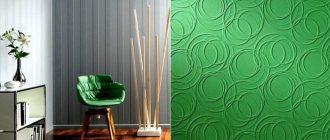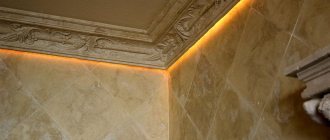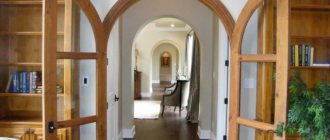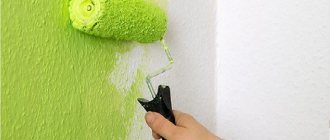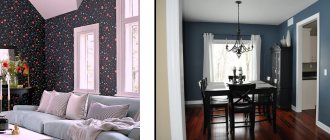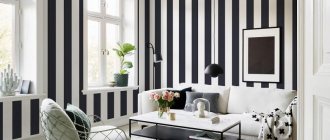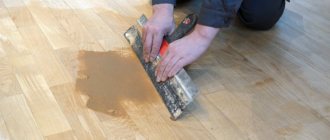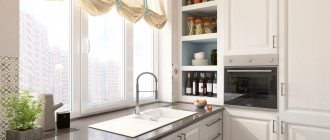Paintable wallpaper is wallpaper intended for periodic repainting. Various manufacturers recommend paint your wallpaper from 5 to 15 times.
Recently, paintable wallpaper has become more and more popular and there are many reasons for this. It is not necessary to make repairs and put up new wallpaper every time your child paints them; just spend half a day repainting and you have a new interior . It's also very easy to update the look of your room by choosing a different color.
Paintable wallpaper comes in several types , which can satisfy almost any buyer. Today, online stores offer the purchase of paintable paper non-woven wallpaper , vinyl wallpaper , and fiberglass wallpaper . Each type of wallpaper has its own advantages and disadvantages.
Paintable wallpaper can be used in any room , it can be a bedroom, living room, children's room, corridor, hallway, kitchen and even a bathroom. Wallpaper for painting is covered with a special water-repellent layer so that the paint does not soak through the wallpaper, so this wallpaper is also suitable for the bathroom. The only thing you need to take into account is that this is still wallpaper and the bathroom should be spacious and have a good ventilation system.
According to reviews , one of the best manufacturers of wallpaper for painting is the German manufacturer Marburg, but there are also many positive reviews about other manufacturers. Basically, when choosing wallpaper for painting, buyers are guided by the price of the wallpaper and wear resistance .
What is non-woven fabric made of?
Non-woven wallpaper is a common name for two types of coatings that contain a substance called non-woven wallpaper. This is a fairly durable material. Some seamstresses even sew interlining to the garment to make these areas stronger and tighter.
Outwardly it looks like paper, but feels more like fabric. So, let's look at the composition of non-woven fabric. The basis of non-woven fabric can be considered cellulose; more than 70% of the material consists of it. Cellulose fibers are arranged in a certain order and impregnated with various substances, which make up the remaining 30%.
All components are pressed, and thus a non-woven fabric is formed. It differs from paper in increased strength and wear resistance. Also, wallpaper that contains non-woven lining has increased protection from mechanical stress, is moisture-resistant and fire-resistant. This material allows air to pass through perfectly, which will prevent the formation of mold and mildew.
Non-woven wallpaper and its features
Non-woven fabric is a strong non-woven base. The composition of such wallpaper is cellulose and synthetic fiber. The material is made entirely from environmentally friendly raw materials, it is breathable and resistant to fire. Due to the non-woven fabric, such wallpapers are much stronger than paper ones.
These wallpapers are absolutely low maintenance. They are resistant to changes in humidity, as well as strong temperature fluctuations.
Types of non-woven wallpaper
There are two types:
- non-woven wallpaper contains only non-woven wallpaper. It consists of several layers. All of them are distinguished by their evenness and smooth surface. The top one is often embossed and has a pattern. Such wallpaper is often purchased for subsequent painting. Due to their density, they can withstand repeated repainting, which will allow you to update the interior of the room without much expense;
- non-woven wallpaper. They have only a bottom non-woven layer, and the top consists of paper or vinyl. The bottom layer is used for wallpapering, and the top layer determines how the canvas will look. The throughput of the coating and the possibility of future painting depend on the top layer. The price of the product also depends on the composition.
Specifications
The main advantage of non-woven wallpaper is the possibility of long-term use. Good quality is ensured by the top layer. Depending on the composition of this layer, they can be painted, washed, or even cleaned with a brush.
To glue wallpaper you need to buy special glue. Since non-woven wallpaper is quite heavy, the glue must be appropriate. Before purchasing, be sure to consult with the seller, he will advise which glue will be most suitable. The gluing process itself is quite easy, because the adhesive solution only needs to be applied to the wall; the canvas itself does not have to be processed. This will save you a lot of money and make the task a lot easier. Remember that the walls should be plain, since transparent non-woven lining will not always be able to hide color differences.
To paint non-woven wallpaper, you need to use water-based paints. They contain no solvent, so they are harmless to humans.
As for the environmental safety of non-woven fabric, everything is in order here too. Since the base is cellulose, we can say with confidence that it will not cause harm to health. The remaining components, when used properly, do not emit harmful substances, so there is no need to worry here either. The only danger for allergy sufferers is the dust that can form on the surface. To avoid this, carry out wet cleaning as often as possible.
We recommend buying wallpaper and glue from trusted places and before purchasing, be sure to ask for documents and certificates that will confirm the quality of the products.
Non-woven wallpaper sizes
The standard length of non-woven wallpaper in a roll is 10.05 meters, and the width is approximately 0.53 meters. But depending on the variety, the sizes may vary. There are so-called meter wallpapers, where the width is 1.06 meters. Also, for example, wallpaper made specifically for painting can have even larger sizes, so before purchasing, be sure to study the markings on the roll; the length and width will be indicated there exactly.
Wallpaper type and size
Coatings from different components are produced in different sizes. When you know the size, sometimes it is possible to determine the type of canvas or vice versa.
Generally accepted production rules are:
- Paper webs are small in size. The width is often standard and is 53 cm.
- Foamed vinyl sheets can be either meter or half meter. Meter versions are produced exclusively with a non-woven backing.
- Hot stamped vinyl products are often made in large widths.
- Most silk fabrics have small widths.
- Materials for further coloring are long and can be produced in different widths.
- If the dimensions do not fit any standard, then vinyl wallpaper made in Europe is used. The cost of such products is quite high and they are often used to implement unusual design solutions.
- The sizes of photo wallpapers may vary; they are indicated on the product packaging.
As you can see from the article, the sizes of wallpaper coverings can vary quite a lot. There are standard solutions with a given width and height, but there are also a large number of other options. So-called meter-long canvases have a number of advantages over half-meter ones; they will significantly simplify the gluing procedure. Using the images used in the article, you can see all the coating options.
Advantages
Like other varieties, non-woven wallpaper has its advantages and disadvantages. There are a huge number of factors in favor of such a purchase. Let's look at the main ones:
- material density that will provide good protection;
- fire resistance;
- fairly easy gluing due to the large size of the roll;
- possibility of painting the coating in the future;
- environmental friendliness, which is especially important for allergy sufferers;
- durability.
How to choose the right non-woven wallpaper - the main characteristics can be found in the following video:
You can even glue such wallpaper on walls that have minor defects. Indeed, due to their density and size, they can easily hide cracks and irregularities. This will save a lot of time and effort that you would have spent on pre-treatment of the surface.
Due to the fact that the glue only needs to be applied to the wall, there is no need to free up space to apply the glue to the canvas. And thanks to the large width of the roll, after gluing, the number of joints will be reduced to a minimum, and the process itself will go much faster.
The wallpaper itself does not get wet from the adhesive solution and does not stretch. If the strip is glued correctly, no bubbles or blisters will form. Working with such a coating is a pleasure. They can be glued to both walls and ceilings. Removing the old finish is quite simple; you don’t even have to pre-wet the surface. And in addition to the above, such wallpaper is very easy to clean from dirt, which will be a big advantage for finishing the kitchen.
What are the properties of non-woven wallpaper?
To produce non-woven fabric, long cellulose fibers are taken. This gives them:
- Wallpaper made from this material does not get wet and is wear-resistant. Unlike paper materials, they are more difficult to spoil.
- When compressed or wrinkled, the interlining easily straightens out.
- Non-woven wallpaper does not attract dust and is difficult to get dirty. Washing is allowed if necessary.
- This type of wallpaper is very resistant to fire.
- Suitable for absolutely all categories of people.
- It is not afraid of dampness due to its moisture-repellent properties. Thanks to its qualities, it has a very long service life.
Thus, it is no coincidence that this type of finishing material has gained great popularity. In addition to excellent quality, positive aspects include the softness of the material and ease of working with it. If paper wallpaper requires a certain skill, since it is easy to damage, then even a novice master can handle non-woven wallpaper. When the time comes to change the wallpaper, it will peel off very easily from the wall surface without causing much trouble.
Flaws
This coating also has disadvantages. These include:
- a lot of dust will accumulate on the textured surface, so cleaning will need to be done regularly;
- a large design that is applied to the canvas can be damaged by a child or animals, so take this factor into account when purchasing;
- When purchasing wallpaper for painting, be prepared for additional costs for the paint itself;
- some types have a fairly high price, so be prepared for material costs.
As mentioned above, non-woven fabric is a transparent material, so the wall should be a single color, be sure to take this into account when gluing. Do not forget to remove excess glue, it can damage the surface.
Designations
Before purchasing non-woven wallpaper, be sure to review the markings on the rolls. There may be a lot of useful information there that will help you make your choice. For example, the roll dimensions or degree of protection are indicated there. To make it easier for you to understand, all symbols are shown in the photo:
Symbols symbolizing the quality mark may also be used. For example, CE marking means that the manufacturer confirms the product’s compliance with European quality directives.
A little bit of history
The name non-woven wallpaper comes from a German word that means a class of non-woven materials that are similar to paper. Non-woven fabric is made from cellulose fibers, which are glued together without glue. Non-woven fabric is a trademark of Freudenberg & Co. KG.
However, in addition to sewing production, such material has also begun to be used for the manufacture of wall coverings, packaging, screens, and medical dressings.
The material is highly durable (more than paper). It does not lose its shape in water and does not shrink after getting wet. Therefore, wallpaper manufacturers began to use non-woven fabric as a base for various types of wall coverings.
Non-woven wallpaper GOST
GOST 6810 2002 defines the basic properties that fully comply with European standards. The standard does not apply to fiberglass and photo wallpaper. According to GOST, the structure of non-woven wallpaper can be of two types: smooth and embossed. According to GOST 6810 2002, the fabric can be of the following types: embossed, profile, velor, with decor.
Also, according to GOST 6810 2002, the coating is divided into grades: waterproof, washable, with increased durability, and with increased protection from mechanical damage. In the case of a specific use, it is the brand of material that needs to be taken into account. For example, in a children's room or hospital you cannot glue GOST grade M-2 non-woven wallpaper, and for hospitals only GOST grade M-3.
As you can see, non-woven wallpaper has a lot of advantages. Due to their strength and size, they can be glued in almost any room. But before purchasing, we recommend that you carefully consider the markings on the roll to avoid possible problems in the future. Also take into account all GOST recommendations. Watch the following video, it will help you learn more about non-woven wallpaper:
Recommended Posts
3d wallpaper for the living room + photo
How to properly glue wallpaper on drywall with and without putty…
How to hang wide wallpaper
Beige wallpaper in the interior
Brick wallpaper in the hallway and corridor
How to glue wallpaper with your own hands
Method No. 1
The calculation based on the area value is as follows:
- The height and length of each wall intended for pasting is measured, and the area of the entire surface is calculated.
- If necessary, the area of window and door openings is subtracted from this value. The resulting value in m2 is the required amount of coverage.
If there is only a small window and a single-leaf door in the room, then their sizes are usually not taken into account in the calculations, leaving the expected surplus “as a reserve”. In the case of a non-standard layout (panoramic window, several or enlarged doorways), the difference can reach up to a whole roll, which means it makes sense to calculate the working surface area as accurately as possible.
- Now we determine how many square meters are in each roll of wallpaper. To do this, the length of the tube is multiplied by its width.
- It remains to calculate the number of tubes themselves. The working surface area is divided by the square footage of material in one roll and rounded up to a larger whole value.
USEFUL INFORMATION: Vinyl wallpaper on a paper basis: glue without problems
Example:
The width of the wallpaper is 50 cm (0.50 m), the footage is 15 m.
Room height – 2.7 m, parameters – 4 × 2.8 m, window and door of standard sizes.
- 4 × 2.7 = 10.8 (m2) – area of one wall.
- 2.8 × 2.7 = 7.56 (m2) – area of the other wall.
- 10.8 × 2 + 7.56 × 2 = 21.6 + 15.12 = 36.72 (m2) – total surface area for pasting.
- 0.50 × 15 = 7.5 (m2) – coatings in one roll.
- 36.72: 7.5 = 4.8 (round to 5)
